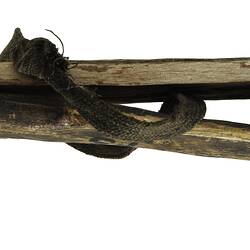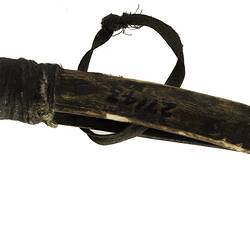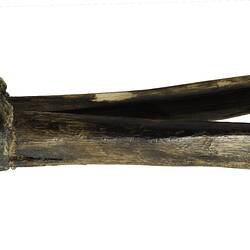Summary
The provenance of this axe-head is unknown, but it may have been collected in the Hopetoun area of northwest Victoria which is the traditional lands of the Wergaia peoples. The Wergaia language was originally spoken over a wide area in the north-west of Victoria. The speakers of Wergaia and several smaller associated groups formed the Wotjobaluk groups of tribes. There is a large amount of language information for the Wergaia Language groups because of the work undertaken by the Moravian Mission at Ebeneezer. Currently the Wotjobaluk groups are working towards publishing a Wergaia Dictionary which was developed with many members of their community and Elders in 2009.
This axe-head is made from greenstone - a rock typically dark green in colour due to the high chlorite content - which was often selected for making tools as it is tough and easy to grind. Much of Victoria's greenstone can be traced to Wil-im-ee Moor-ring (Woi Wurrung language for tomahawk place) also known as Mount William. Wil-im-ee Moor-ring is one of Victoria's six greenstone quarries which are in a formation aligned north to south throughout central Victoria. Greenstone hatchet heads were prestigious items traded over much of south-eastern Australia, creating social links and obligations between neighbouring groups. The greenstone originating from Wil-im-ee Moor-ring had a wide distribution reaching a distance of up to 800 kilometres, and can be traced northwards across the Murray, up the Darling River as far as Broken Hill, across western Victoria into South Australia and to the mouth of the Murray River.
Many stone tools used by Aboriginal peoples throughout Australia were 'hafted' - a technique which involves fitting the tool with a handle, usually made from a supple piece of wood, vine or cane around the body of an axe-head, and tying the two ends together with sinew or handspun string. Resin created from plants such as spinifex, or native bees wax, were also used to further secure the head and handle. Hafted axes or hatchets were used to open hollow logs to retrieve possums, birds or 'sugarbag' (native honey), or to cut toe-holds in tree trunks.
Physical Description
A hafted axe with a ground head attached with string or fibre and resin. The wooden handle is secured at the end with string.
Significance
The Traditional Owners of Wil-im-ee Moor-ring, the Wurundjeri peoples, dug deep pits to reach the unweathered stone underground, or heated the surface of outcrops (above-ground boulders) to break away pieces of rock. Using a large boulder as an anvil, they shaped the stone into a roughed-out hatchet head. The hatchet heads were traded in their rough form, then worked, polished and shaped by their new owners to meet their specific requirements.
Today you can see the remains of hundreds of mining pits and the mounds of waste rock that surround the old work stations where the Wurundjeri made the greenstone hatchets.
Wil-im-ee Moor-ring in central Victoria was famous amongst Aboriginal groups throughout south-east Australia as the source of the highly valued greenstone hatchet heads.The cultural significance of Wil-im-ee Moor-ring to the Wurundjeri people is illuminated by firsthand accounts given by prominent Wurundjeri leader William Barak to ethnographer Alfred Howitt in the 1880s;
'There were places in which the whole tribe had a special interest. Such a place was the "stone quarry" at Mount William... When neighbouring tribes wanted stone for tomahawks they usually sent a messenger for Billibellary [the main custodian]. When they arrived they camped around about the place. Billibellary's father when he was alive split up the stones and gave it away for presents such as rugs, weapons, ornaments, belts, necklaces'. William Barak.
References: http://www.vaclang.org.au/languages/wergaia.html
More Information
-
Object/Medium
Axe, hafted
-
Maker
-
Locality
-
Date Produced
-
Date Collected
-
Object Measurements
340 mm (Length), 130 mm (Width), 70 mm (Height)
-
Classification
-
Date Made
-
Maker
-
Clan/Language Group
-
Place Made
-
Indigenous Region
-
Keywords
-
Type of item
-
Discipline
-
Category
-
Collecting Areas




